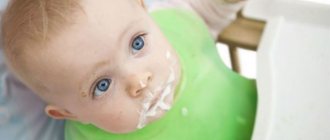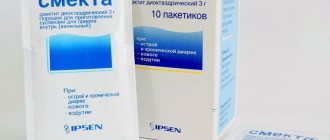Published 01/04/2019 · Comments: · Reading time: 4 min · Views: Post Views: 1,733
A common cause of anxiety for a young mother is the child's rare bowel movements. But the absence of stool for several days does not always mean constipation in a newborn. If the baby is bottle-fed or mixed-fed, he must poop every day. If a child eats only breast milk, he may not have stool for a whole week - this is one of the normal options. Drinking breast milk is well absorbed by the body. You can recognize that a newborn is constipated if there are several signs of the disorder.
How to tell if your child is constipated
Constipation is usually called difficult, irregular, and in some cases even painful bowel movements. Constipation occurs due to impaired functioning of the gastrointestinal tract. It is very difficult to identify this problem in time, since the bowel movements largely depend on the age of the child. In this case, stool retention may occur for several days or be absent altogether: daily bowel movements will still be considered constipation.
So how can you tell if your baby is constipated? There are symptoms of this disease. These symptoms include:
- The baby is weak and spits up often. Vomiting may be profuse.
- The color of the skin has changed. Basically, the skin becomes grayish in color. This happens due to intoxication during prolonged constipation. For the same reason, rashes may appear on the skin.
- There are blood streaks in the formed stool.
- Feces alternate: first, small peas are released, and then liquid contents.
- Body temperature rises.
- The baby's sleep is disturbed, he refuses to breastfeed, becomes restless and capricious.
- The child pushes, while raising his legs and crying.
- Defecation did not occur for more than 2 days.
- The consistency of feces is dry and hard.
Depending on the age of the baby, there is a norm for his bowel movements:
- A newborn baby has bowel movements approximately 5–8 times a day. It all depends on the number of feedings.
- In the second month - from 3 to 5 times a day.
- On the third - approximately 1 or 2 times a day.
- At 4–6 months - once a day.
- During the period 6 - 24 months - from 1 to 3 times a day.
- After 24 months, the number of bowel movements should be 1 time every 1–3 days.
If your baby has bowel movements less often, he is constipated. The child may complain of pain in the tummy. During the process of defecation, the child strains, and emptying is difficult. The feces become hard and have an unusual color and consistency. If a child's stool comes out in the form of balls and resembles sheep's in appearance, then he is constipated.
Why is it necessary to treat constipation in a child?
Constipation in a child means more than just difficulty going to the toilet. Systematic untimely bowel movements can have a detrimental effect on the gastrointestinal tract and the entire body as a whole. Chronic constipation to varying degrees can cause the following consequences:
- Violation of the digestion process of food during constipation leads to poor absorption of nutrients, vitamins, and microelements, which threatens the development of anemia, weakness, and decreased immunity.
- At the same time, decay products from accumulated feces are absorbed into the blood through the intestinal walls and poison the body. Signs of intoxication can manifest themselves in lethargy, drowsiness, decreased activity, loss of appetite, etc.
- Stagnation in the intestines introduces disharmony into the balance of beneficial and pathogenic microflora, which cannot but affect the body's resistance to diseases and the digestion process.
- Feces stretch the intestinal walls, further aggravating constipation, causing inflammation of the mucous membrane, spastic pain, increased gas formation, and impaired local circulation.
- Persistent constipation leads to rectal cracks, bleeding from the anus, and pain. The child is afraid to go to the toilet and develops neurological problems.
How to help a child with constipation?
If all attempts to poop end in vain, the parents’ task is to alleviate the child’s condition and help him cope with constipation. Although many laxatives are allowed for preschoolers, parents should try not to use them without a doctor's prescription.
Glycerin suppositories and a cleansing enema are quite suitable as first aid for a child. Rectal suppositories with glycerin are given even to newborns; they are safe and effective.
If there are no candles, you can make an enema from a glass of boiled cool water. It is recommended to add 1-2 small spoons of glycerin to the enema water. Sometimes a saline enema is recommended, but it can cause burning and pain.
When administering an enema, safety precautions must be observed.
- The pear must be disinfected and the tip lubricated with oil or baby cream.
- Water can only be used cold, no warmer than room temperature, otherwise it will be absorbed into the intestines, carrying with it toxic products released by stagnant feces.
- You should not pour a lot of liquid into the rectum, as it can be injured or stretched, causing pain and sharp spasms.
These measures should be enough to obtain a laxative effect at home, after which the child needs to call a doctor or take him to a pediatrician at the clinic. You should not often resort to such remedies, since this is not a treatment, but a temporary elimination of the symptoms of difficult bowel movements.
You should immediately consult a doctor without attempting an enema if your child:
- severe abdominal pain, gurgling, symptoms of intoxication;
- blood from the anus;
- involuntary stool, when, against the background of persistent constipation, liquid stool leaks out.
Treatment of childhood constipation
If a child is bothered by constipation, parents should not ignore this fact and try to cope with the problem on their own. This issue should be addressed by a pediatrician who will prescribe tests (blood, urine, coprogram, feces for helminths) and refer the child to the necessary specialists: a surgeon, gastroenterologist, endocrinologist, neurologist, etc.
A set of therapeutic measures should be aimed at achieving regular and natural cleansing of the child’s intestines (daily or at least every other day), preferably at the same time. The baby should defecate without straining, with stool of normal density and consistency.
Treatment of constipation in a child is an individual case, which takes into account all available factors: the severity of the disease, its causes, the presence of pain, the age and psychological characteristics of the baby, and concomitant diseases. Parents need to be prepared that the treatment will last more than one month. Complete restoration of intestinal functions and elimination of the child’s associated psychological problems can take up to 2 years.
Therapeutic diet
As a rule, the first measure for constipation is a laxative diet. This is one of the most important links, without which the fight against constipation is impossible. However, organizing therapeutic nutrition for a child is not so simple. Most often, doctors ask parents to change the eating habits of the whole family - this will make it easier for the child to endure “deprivation” and adapt to the new diet.
- Avoid foods that cause stool thickening. These are baked goods, rice porridge, pasta, whole milk, and fruits - bananas and unpeeled apples.
- Exclude gas-forming foods: cabbage, legumes, mushrooms, tomatoes.
- Avoid eating foods that reduce intestinal motility. These are tannin- and caffeine-containing products (tea, coffee, cocoa, chocolate, blueberries), enveloping soups and cereals, jelly.
- For rapid transport of fecal matter through the intestines, they must be formed in sufficient quantities. To achieve this, the menu is based on dishes containing coarse fibers. These are vegetables, fruits, grains. It is useful to add bran to food and eat whole grain bread. The amount of fiber recommended for consumption by children over 2 years of age is calculated based on the child’s age: it is equal to the number of full years of the child plus 10 grams on top.
- The rest of the diet is supplemented with “neutral” products: lean meat, chicken eggs, oils.
- The child should drink a lot; the drinking regime is based on clean, unboiled water (filtered, bottled), without gases, without additives.
- Be sure to include a sufficient amount of fermented milk products in your diet. These are yoghurts without additives, kefir, yogurt, bifido drinks.
- If a child is diagnosed with inflammation in the intestines, he is transferred to strict adherence to the diet - table No. 3 or No. 4 for children.
Daily regime
In the treatment of childhood constipation, importance is attached to organizing a stable daily routine. It is necessary that meals, trips to the toilet, etc. always happened at a certain time. This way, the child will develop the habit of having a bowel movement every day at approximately the same time, preferably in the morning. At the same time, he will be ready for the act of defecation both psychologically and physiologically.
Parents should also instill in their child the habit of starting the morning with one glass of cool water and exercise. If, after drinking water, the urge to go to the toilet does not occur, the child needs to warm up, have breakfast and try to poop again.
Physical activity should also occur during the day. Gymnastics helps to activate intestinal motility and move leftover food through the digestive tract. The following exercises are especially useful:
- squats;
- bends;
- swings with straight and bent legs;
- bringing the knees to the stomach;
- abdominal exercises
Skating, cycling, running, outdoor games - any movement engages the anterior abdominal wall and forces the intestinal muscles to work. Young children can be invited to practice in a playful way: scatter beads on the floor and collect them, fully unbending, lifting each of them, etc.
Restoration of bowel movements
If you have problems with constipation, you need to teach your child, no matter how strange it may sound, to poop correctly.
- You need to explain to the baby that the doctor will soon cure his butt, so going to the toilet will not hurt. Even if it’s unpleasant now, you should still try to poop at the same time.
- The child needs to create comfortable conditions. If he goes to the potty, then buy a comfortable potty, make sure that it is not cold. Leaving a child alone in the toilet or morally supporting him - every parent knows better than his child. The main thing is not to scold him under any circumstances and to praise him when he succeeds.
- The most effective posture for bowel movements is squatting, with your legs pressed to your stomach. If sitting, then place a stool under your feet. You can massage your stomach with your hands. The child can help the process of defecation if he quickly retracts and relaxes the anus or presses his finger on the point between the anus and the tailbone.
Pharmacological assistance: what to give a child for constipation?
If necessary, the doctor will prescribe treatment with laxatives. Since laxatives can be addictive, as well as side effects such as allergies, drug-induced diarrhea and other troubles, their therapy in children should not last more than 2 weeks.
Children under 3 years of age are allowed lactulose-based laxatives, for example, Duphalac and its analogues. It is a safe drug prescribed even to pregnant women to increase the volume of feces and gently stimulate intestinal motility. The dosage of Duphalac is increased gradually, starting with 5 ml of syrup, and then gradually reduced.
Medicines from two groups are designed to eliminate sluggish bowel function and relieve spasms: prokinetics and antispasmodics. The former significantly activate the digestive tract, starting with the expulsion of food from the stomach and ending with toning the entire intestine. One of these drugs is Domperidone, which normalizes stool, relieves abdominal pain and eliminates gas. Children are prescribed 0.5 - 1 tablet before meals 3 times a day for a month. Children are given the medicine in liquid form.
In case of intestinal dysfunction, expressed in spasms (the so-called irritable bowel syndrome), children are prescribed antispasmodics - No-shpu, Papaverine, belladonna in suppositories for one to one and a half weeks.
Also, children with a tendency to constipation are shown herbal choleretic drugs, such as Chofitol. Their task is to replenish the deficiency of digestive juices, stimulating the production of bile and pancreatic secretions. This allows the child to better absorb food and quickly remove unprocessed remains from the body.
Preparations containing bifidobacteria and lactobacilli are recommended for all children with constipation to treat dysbiosis and restore healthy intestinal flora. These include Linex, Bifidumbacterin, Hilak Forte and others.
Causes of constipation in a baby
Before you begin to treat constipation in your baby, you need to find out the cause of its occurrence. There can be many such reasons:
- Pathologies of internal organs are congenital.
- Insufficient physical activity.
- Taking medications and antibiotics.
- Factors of psychological origin: an uncomfortable potty, a change in the usual environment, and others.
- Metabolic disease.
- Drinking insufficient amounts of liquids. This reason is mainly relevant for children who are bottle-fed.
- Food allergies.
- Unbalanced diet.
- Lactase deficiency.
- Intestinal dysbiosis.
- Incorrect regimen and diet of a nursing woman.
- Thyroid diseases.
- Iron deficiency.
Each baby has its own bowel movement routine. Dr. Komarovsky claims that if the baby has bowel movements once every three days and his condition is normal, there is no need to panic. This is a sign that mother's milk is completely absorbed. But if you notice symptoms of painful constipation in your baby, you should take action immediately.
If stool does not pass for more than three days, contact a specialist as soon as possible. Such a symptom may indicate intestinal obstruction, which requires surgical intervention.
Prevention and treatment
Before treating constipation in a child, you should consult a gastroenterologist.
Stimulating emptying using the above methods is relevant only for a one-time problem. If constipation occurs systematically, then you need to contact a specialist.
- The attending physician will refer you for an ultrasound and if a pathology is detected, then first there will be an attempt to solve the problem with medication, otherwise - surgically. It is possible to visit a neurologist (constipation due to neurological disorders), a gastroenterologist (gastrointestinal diseases), an endocrinologist (diabetes, hypothyroidism provoke constipation), an immunologist (food allergies). Preventive actions against constipation:
- Adjusting the diet of a nursing mother. It is recommended not to eat foods that bind and drink plenty of water (2.5 l/day). Increase the consumption of vegetables, fruits, wholemeal products, dried fruits. When feeding your baby, give vegetable and fruit purees.
- Perform daily tummy massage and exercises.
- Improve the condition of the intestinal microflora by consuming fermented milk products, probiotics, bifidobacteria and lactobacilli.
- Drink your daily amount of water. Mother and baby should drink clean “living” water, that is, not boiled.
Brief recommendations for families whose children suffer from tummy problems:
- give preference to breastfeeding;
- do not introduce complementary foods ahead of schedule;
- if there is no milk, choose a good mixture, preferably fermented milk;
- maintain the correct amount of food your child consumes;
- if you are prone to constipation, feed your child a small amount of prunes and limit the consumption of semolina and rice;
- lead an active lifestyle;
- when using antibiotics, do not forget to take probiotics;
- a nursing mother should limit herself in taking medications during lactation that cause constipation in the child (iron-containing medications, antispasmodics, sedatives, etc.)
Read: Will an enema help children with constipation?
What to do for constipation in a baby - in thematic video material:
https://www.youtube.com/watch?v=w03Vv_qI2ls
Read along with this article:
- A newborn has a stomach ache, what to do, how to help and how to do it...
- Why does a baby have constipation: how to deal with this problem?
- Green poop in a baby: causes, methods...
- What to do if your one-month-old baby has diarrhea? In what cases does not...
- Constipation in a 7-month-old child: what to do, how to help the little belly?
- Note to mothers: normal stool in a newborn
- If a baby cannot go to the toilet - how to help him
- What causes diarrhea in a newborn, what to look for and...
- A collection of tips or What to do if a newborn has loose stools
What to do if your child is constipated
How to help a child with constipation and what to do in this case? First you need to identify the reasons for its occurrence. Taking into account all factors, it is necessary to choose the right treatment and take care of prevention:
- Drug treatment.
- The baby must behave actively.
- Stimulate intestinal function.
- Drink enough liquid.
- Review your baby's diet.
Frequent stimulation of bowel movements in a child is not recommended. This can lead to addiction. Because of this, he will not be able to go to the toilet without outside help. If you have frequent problems with bowel movements, exclude foods that hold stool together from your child's diet: baked goods, rice and eggs. Do not cook food too liquid or soft. In some cases, the porridge should not be cooked to the end. You need to let your baby eat a whole apple.
Your child is constipated - how to help?
In case of constipation, which was caused by poor nutrition or other factors not related to serious illnesses, you can help the baby by giving him an enema. Its volume depends on the age of the baby:
- For a newborn - no more than 20–30 milliliters.
- For infants aged 1 to 3 months - up to 40 milliliters.
- For a child from 3 to 6 months - from 70 to 90 milliliters.
- Babies from 6 to 12 months - 150 milliliters.
- After 12 months - 200 milliliters.
An enema of boiled plain water is given. Complete bowel movement can occur after the first portion of liquid. The liquid used for the enema should be at room temperature. The absorption of harmful substances formed in the intestines can be triggered by warm liquid. The pear with liquid should be administered with extreme caution so as not to injure the intestinal mucosa. Lubricate the end of the bulb with Vaseline oil.
What are the medications for constipation for newborns?
Products with a laxative effect are produced for children from the first days of life. In pharmacies you can purchase medications in various forms: suppositories, syrups and solutions.
Candles
Candles for newborns for constipation
When the problem of bowel movement occurs rarely, children's doctors recommend purchasing rectal suppositories.
Their action occurs locally, and is not so safe for the rest of the body. It is recommended to use glycerin-based suppositories. Used for constipation in babies up to a month old, 1/8 part. From the age of one month, it is allowed to double the dosage.
Suppositories can soften stool and ensure a softer and more painless bowel movement process.
Solutions and syrups
It is important to choose the one from many brands that will really help your baby. Mothers will be helped by a note about the age category of the drug. It is also necessary to carefully study the instructions for use, and, if possible, do not use the medications yourself without a doctor’s prescription.
Laxative Prelax
Prelax - the drug contains lactulose. It improves intestinal motility and improves its natural microflora. After administration, the drug takes effect within an hour. It can also be taken as a preventative.
Normolact is a lactulose-based laxative. The drug is given to the child starting with a high dose, then it is reduced if the desired result is visible. The medicine is not addictive and can be used for a long time.
Duphalac is a laxative made from natural ingredients. The syrup can be used in the treatment of constipation from the first days of a child’s life. The maximum effect of the medicine is achieved within 24 hours after taking it.
Microclyster Microlax
Microlax - the drug acts as a microenema. The desired effect occurs in the near future. The only drawback of the product is the high price.
It is necessary to choose medications yourself only for one-time assistance to the baby. If constipation occurs periodically despite normal eating, you should visit a doctor. Since there is a risk of triggering the development of congenital intestinal pathology.
It is also worth remembering that if constipation is detected in the first weeks of life, this is a physiological norm. The baby's body adapts to the new food.
What to do if your one-month-old baby is constipated
To improve digestion and prevent problems with stool in a baby, it is necessary to place him on his tummy before each feeding. It is recommended to massage your baby's tummy regularly. Lightly press your palm against the baby's tummy and move it clockwise with your hand. The baby can be laid on itself. Your baby's bowel movements will be stimulated by your body heat. Do not give your baby anti-gas drugs if he has problems with bowel movements (Espumizan, Smecta). They can reduce intestinal motility.
If all methods do not bring the desired result, then try to mechanically influence the sphincter in order to make the baby want to empty the intestines. To do this, use the following methods:
- Use a gas outlet pipe.
- Soak a cotton swab in baby oil and insert it into the baby's anus. Twist it a little to stimulate emptying.
- Use a thermometer inserted into the anus.
Soap should not be injected into a child's rectum. This can cause a burn to the mucous membrane due to the alkali it contains.
You can also use glycerin suppositories, which are not absorbed by the intestines and are completely safe for infants. They will help get rid of intestinal problems in 30 minutes. The candle should be placed in the “lying on the back” position for a baby, and for an older child – on its side. In both cases, you need to bend your legs at the knees.
Gymnastics helps a lot. It is performed in a lying position.
- To do this, take the baby by the legs and straighten them. After this, bend them at the joints, pressing them to the tummy. Such actions are repeated approximately 5 – 10 times. After this procedure, press your legs to your tummy and fix them in this position for a few minutes. This must be repeated several times.
- Simulate cycling with one leg, then the other, and finally with both. This procedure is repeated approximately 6 - 8 times.
- Use your baby's knee to reach the elbow, which is on the opposite side. Repeat this procedure 5 – 10 times.
- Exercises with a fitball work well. Place the child on the ball with his tummy down and rock him for at least 2 minutes.
Nutrition plays an important role. With proper nutrition, you can not only recover faster, but also get rid of this disease. A child’s diet must include the following foods:
- Fruits. Prunes and plums are good for constipation.
- Boiled fish or lean meat.
- Coarse bread.
- Soup.
- Low-fat kefir.
- Vegetables in the form of salads using vegetable oil (the more vegetables, the better for the intestines).
Laxatives for constipation in children: more effective than soap and safer than a thermometer!
If a child is older than a year (that is, one who is already fed less breast milk or formula, and mainly consumes “adult” food) has not had a bowel movement for more than two days, and at the same time he has no signs of poor health (that is, he is constipation is not one of the symptoms of any disease), parents are quite capable of helping such a child on their own, without the intervention of doctors. For example, as is the case with infants, they may use special laxatives.
Typically, laxatives work in one of the following ways:
- Some laxatives stimulate the swelling of feces - they begin to put pressure on the walls of the rectum, causing them to contract, and thus causing the urge to defecate.
- Other remedies work by retaining fluid in the intestines, which also puts pressure on the walls of the rectum.
- Finally, there are drugs that increase intestinal motility (contraction of the muscle tissue of the intestinal walls).
Typically, pediatricians advise parents (especially children in their first year of life) to use one of two laxatives, which have proven to be effective and safe remedies for constipation in children. So, if your child does not have any signs or symptoms of any illness, and constipation is the only thing that worries you as a parent about his condition, you can use:
- or lactulose syrup (this is the international name of the active substance, and, as you understand, there can be dozens of commercial names);
- or suppositories with glycerin .
What to give a child for constipation
If the methods listed above do not help, then you can use medications. In order to avoid addiction, the drugs are used for no more than 14 days. This procedure is rather a forced measure, but not the norm.
At home, to help children, it is recommended to give the following medications:
- Probiotics. These medications eliminate dysbiosis and establish normal intestinal microflora. Similar products include Hilak Forte, Acipol and Linex.
- Choleretic drugs that improve digestion. As a result, food is better absorbed and eliminated from the body without much effort. A representative of such drugs is Hofitol.
- Antispasmodics. Relieves pain. Papaverine and No-shpa have precisely these properties.
- Enzyme products. They help food digest. These are Panzinorm, Creon and Mezim.
- Prokinetics. Drugs that stimulate intestinal function, causing the intestines to empty themselves. These drugs include Motilak and Domperidone.
- Mild laxative - glycerin suppositories, Senade, Microlax and Duphalac.
Products containing lactulose (Duphalac) are effective for infants. This drug should be started with 5 milliliters.










